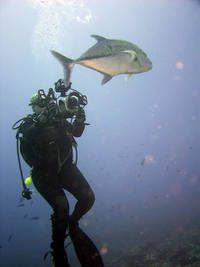March 16, 2005
Cayos Cochinos, Honduras. Wednesday, March 16th 2005
We arrive at night at La Ceiba – at Lagoon Marina, specifically – and happily we are met at the mouth of the port and shown to our mooring. Suddenly the vastness of the ocean is replaced by a narrow corridor of green water lined by lush, extravagant vegetation, mangroves, herons that wake in the darkness at our approach and flap their wings before returning to their chosen branch to pass the night.
The next day we spend filling water tanks, buying food, and handling other logistics that always take more time than you expect. At this point two of our crew disembark; we are sad to see them go but glad to know they will join us again in Florida.
When we leave the port we are even more aware of the variety of plant species around us. In this stretch we encounter the boats called “tanqueros,” which carry dozens of “pangas” (little canoe-shaped boats). And why? When they find an area rich in lobsters, the divers fan out in the pangas to cover the entire capture zone. Dive lobster fishing, practiced on a large scale, is not only depleting the resource but also causing the paralysis and death of dozens on fishers in Miskito and Garifuna Indian communities in this area; the divers must complete up to 12 dives each day, without adequate equipment and without the necessary intervals in between.

Looking behind us again we see the mountain range Nombre de Dios, with its highest peak, Pico Bonito, which stretches roughly 2800 meters from sea level. All of the range is a protected area.
Little by little the port recedes, and ahead of us appear small white and green spots. They become the profiles of small islands, keys and dozens of submerged peaks called “bancos” that correspond to the group of underwater mountains called Cayos Cochinos. In recent years, Hurricane Mitch – in addition to prior coral bleaching – caused serious damage to the area’s ecosystems. Hawksbill turtles nest on some of the keys’ beaches.
As we arrive, a launch called “Tiburon” comes out to meet us. It belongs to the Honduran Coral Reef Fund, also known as the Cayos Cochinos Fund (Fundación Cayos Cochinos).
The Ranger divers go out to check their recently-purchased equipment – cameras, cases, etc. For their first dive in the keys they go to Pelican Point, at the west end of Cayo Cochino Mayor. The rest of the crew undertakes the necessary equipment repairs and transfers to prepare for the four days of work ahead. Cochino Menor is the operations and research base of the Marine Natural Monument of Cayos Cochinos, so here there are laboratories, cabins where scientists are housed, park rangers and sailors from the Honduran navy, all of whom help to guard the protected area. They are the only inhabitants of the key. Well, them and a pair of parrots and two hawksbill turtles (Eretmochelys imbricata) barely five months old who swam here at the end of last year’s nesting season and will soon be set free.
As has been the case in all of the sites we have visited so far, we are overwhelmed by the warm reception we receive and by the willing collaboration of the NGOs that, working with Central American governments, are managing these protected areas in a professional and exemplary manner.
When our colleagues return from the dive, all the equipment fine, they describe the number of species they have seen and filmed, including a Nassau grouper (Epinephelus striatus) – one of the objectives of our expedition, since this species is disappearing throughout the Caribbean, targeted both by commercial overexploitation and by heavy sport fishing. We are all excited.
Hoping to see similar marvels in shallower waters, we put on our masks and fins and find our reward: barely ten meters from the dock we find, first, a meadow of marine grasses. Specifically, this is turtle grass (Thalassia testudinum) mixed with manatee grass (Syringodium filiforme), in which there are a few sea urchins (Lytechinus variegatus), snapper, and a torpedo ray (Narcine sp.). But a bit farther out, a shallow coral reef with a multitude of black gorgonias (Plexaura spp.), Venus’ fans (Gorgonia flabellum), staghorn coral (Acropora prolifera), encrusting coral (Montastraea sp.), star coral (Solenastrea sp.), brain coral (Diploria sp.), maze coral (Meandrina meandrites) and lettuce coral (Agaricia sp.). And growing on many of them, the beautiful Christmas tree worm (Spirobranchus giganteus).
In this extraordinary oasis we see, in just a few minutes, foureye butterflyfish (Chaetodon capistratus), blue tang (Acanthurus coeruleus), French grunts (Haemulon flavolineatum), tomtates (Haemulon aurolieneatum), longfin damselfish (Stegastes diencaeus), sargeant majors (Abudefduf saxatilis), brown chromis (Chromis multilineata), redtail parrotfish (Sparisoma chysopterum), bluehead wrasse (Thalassoma bifasciatum), yellow goatfish (Mulloidichthys martinicus), longspine squirrelfish (Holocentrus rufus), trumpetfish (Aulostomus maculatus), rock hind (Epinephelus adscensionis), red-spotted hawkfish (Amblycirrhitus pinos), pargos or lane snapper (Lutjanus synagris) and many other species that we don’t have time to identify.
And over us, magnificent frigatebirds (Fregata magnificens) and brown pelicans, (Pelecanus occidentalis), some of them fishing.

